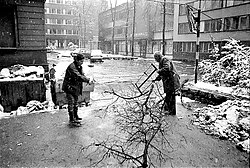The Yugoslav Wars or the Balkan Wars were fought during the 1990s as part of the process whereby communist Yugoslavia disintegrated into seven different countries. Ever since the end of World War I, a broad section of the Balkans had been ruled as part of the Kingdom of Yugoslavia, which subsequently became communist Yugoslavia after World War II. The communist state there began to collapse as the Cold War came to an end and different national groups within Yugoslavia began pressing for independence. In some instances, such as with Slovenia, this was a relatively peaceful process, but wars were fought in most cases to prevent the constituent parts of Yugoslavia seceding from Serb rule in Sarajevo. The most bitter of these was the Bosnian War which took place between 1992 and 1995 and which involved ethnic cleansing on the part of the Serb aggressors. Despite such measures, the Serbs were unable to prevent the disintegration of Yugoslavia and eventually the new nations of Croatia, Slovenia, Bosnia and Herzegovina, Macedonia (North Macedonia since 2019), Kosovo and Montenegro all emerged, with Yugoslavia eventually abandoning its name and reverting to being known as Serbia. The Yugoslav Wars caused considerable displacement and migration.[1]
Yugoslav Wars chronology of eventsYugoslav Wars chronology of events
The nation-state of Yugoslavia emerged gradually in the late nineteenth and early twentieth centuries out of the idea that the Slavic peoples of the Balkans such as the Serbs, Croats and Slovenes should live within a united Slavic state. This idea was fostered in particular by the Serbs after they achieved full independence from the Ottoman Empire in 1878. Its opportunity to do so arose following the end of the First World War and the collapse of the Austro-Hungarian Empire, through which Serbia acquired extensive new lands in the western Balkans. Thus was created the Kingdom of the Serbs, Croats and Slovenes, later renamed the Kingdom of Yugoslavia. The nation-state survived into the post-Second World War era, though as a communist state now ruled by Josip Broz "Tito".[2]
Tito died in 1980, following which Yugoslavia was extremely weakened. There was a growing desire amongst some of the different ethnic groups within the states, such as the Croats, Slovenes and Bosniaks, for greater independence from what they perceived as Serbian domination of Yugoslavia. This was compounded by the collapse of communism globally as the Cold War came to an end in the late 1980s and early 1990s.[3]

The Yugoslav Wars were effectively four different conflicts fought between 1991 and 2001 in order for the nation-states of Croatia, Slovenia, Bosnia and Herzegovina and Kosovo to acquire their independence. Of these the Slovenian War of Independence, fought for just a week and a half between late June and early July 1991, was the least traumatic. The Croatian War of Independence technically lasted for several years, but it was a stop-start affair which the Serbs had little chance of winning.[4] However, the Bosnian War between 1992 and 1995 was a brutal conflict which led to the infamous siege of Sarajevo and the Srebrenica Massacre. A final further conflict occurred in Kosovo in the late 1990s and eventually ended in American intervention against the Yugoslav government led by Slobodan Milošević. Macedonia and Montenegro achieved independence from the wider Yugoslav state through almost entirely peaceful means. By the time Montenegro seceded in 2006, the Yugoslav name had already been dropped in preference for Serbia.[5]
Migration during and after the Yugoslav WarsMigration during and after the Yugoslav Wars
There was substantial migration associated with the Yugoslav Wars. The United Nations High Commissioner for Refugees estimates that between 3.7 and four million people were displaced as a result of the combined conflicts. Of these, the bulk, or some 2.2 million, came from Bosnia and Herzegovina, while hundreds of thousands of Kosovans were displaced and over 70,000 left the country altogether.[6]
Bosnia and Herzegovina presented the most complicated region of all. The country here is a mix of Bosniaks and Serbs, with these also being divided religiously between Muslim Bosniaks and Eastern Orthodox Serbs, although these are not entirely clear-cut. At one stage towards the end of the Bosnian War in the mid-1990s peace proposals included a bizarre plan for dividing the country between different Bosniak and Serb regions that would be accessed through bridges and tunnels. However, this dystopia was overruled in favor of creating a dual-administered country in which Bosniaks and Serbs administer different locations to a greater or lesser extent. This has led to some internal migration within the country.[7]
Demographic impact of the Yugoslav WarsDemographic impact of the Yugoslav Wars

The demographic impact of this was that it eventually led to more ethnically homogenous regions within the Balkans. This primarily occurred as people sought to relocate to the new countries which were emerging in which they would be the dominant ethnic group going forward. For instance, many Croats who lived in Bosnia and Herzegovina, Slovenia or Serbia relocated to live in Croatia as they emerged with a nation-state of their own, while a substantial number of Serbs left Croatia and migrated to Serbia.[8]
Yet some of the impact was felt beyond the Balkans. Many of those affected were Kosovans, which are ethnically Albanians and have a strong ethnic affiliations with their peers on the other side of the border.[9] A large number left the region in the late 1990s, while the general poverty and instability of the region well into the 2000s and 2010s has seen a large Kosovan diaspora develop overseas. There are consequently hundreds of thousands of Kosovans living abroad today, with large centers of migration in the United States, Sweden, Switzerland and Germany. A similar diaspora is associated with Bosniak refugees who fled their homeland back in the 1990s.[10]
See alsoSee also
Explore more about the Yugoslav WarsExplore more about the Yugoslav Wars
- Historical Records: Tracing a family through Yugoslavia, America and Brazil on the MyHeritage blog
- The 1990s Balkan Wars in Key Dates. Voice of America
- The Yugoslav Wars 1991 to 1999. British Library
- Excerpt: The World and Yugoslavia's Wars. Council on Foreign Relations
References
- ↑ Balkans war: a brief guide. BBC News
- ↑ A Guide to the United States’ History of Recognition, Diplomatic, and Consular Relations, by Country, since 1776: Kingdom of Serbia/Yugoslavia. Office of the Historian, Foreign Service Institute United States Department of State
- ↑ The Breakup of Yugoslavia, 1990–1992. Office of the Historian, Foreign Service Institute United States Department of State
- ↑ About: Croatian War of Independence. DBpedia
- ↑ Excerpt: The World and Yugoslavia's Wars. Council on Foreign Relations
- ↑ Where we work. UNHCR
- ↑ What is Republika Srpska? Deutsche Welle
- ↑ Kovjanić, Aleksandar; Pavlović, Mila; Živanović, Vedran; Krstić, Filip. Impact of the War in Croatia (1991-1995) on the Differentiation of Age Structure between Serbs and Croats: A Case Study of the Banija Region. Cambridge University Press. 20 December 2021
- ↑ Mehmeti, Leandrit I. Kosovar Identity: Challenging Albanian National Identity. University of South Australia. Australia and New Zealand Journal of European Studies, 2017.
- ↑ Kosovo Diaspora and its Role Amidst Multiple Crises. United Nations Development Programme